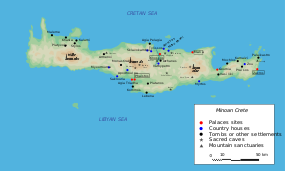
Ancient Greek architecture came from the Greeks, or Hellenes, whose culture flourished on the Greek mainland, the Peloponnese, the Aegean Islands, and in colonies in Anatolia and Italy for a period from about 900 BC until the 1st century AD, with the earliest remaining architectural works dating from around 600 BC.

The Minoan civilization was a Bronze Age culture which was centered on the island of Crete. Known for its monumental architecture and energetic art, it is often regarded as the first civilization in Europe. The ruins of the Minoan palaces at Knossos and Phaistos are popular tourist attractions.
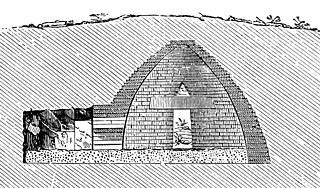
A beehive tomb, also known as a tholos tomb, is a burial structure characterized by its false dome created by corbelling, the superposition of successively smaller rings of mudbricks or, more often, stones. The resulting structure resembles a beehive, hence the traditional English name.

Phaistos, also transliterated as Phaestos, Festos and Latin Phaestus, is a Bronze Age archaeological site at modern Faistos, a municipality in south central Crete. It is notable for the remains of a Minoan palace and the surrounding town.
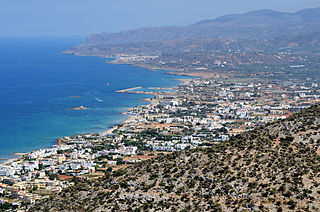
Malia is a coastal town and municipal unit situated in the northeast corner of the Heraklion region of Crete, Greece. It is part of the municipality of Hersonissos and is located approximately 34 kilometers east of Heraklion. As of 2021, the population of the municipal unit was recorded at 5,501. The area also encompasses the villages of Mochos, Krasi, and Stalida, covering a total area of 60.720 square kilometers. Malia is renowned as a tourist destination, particularly known for its vibrant nightlife. Additionally, the town is home to Minoan ruins located three kilometers to the east, spanning an area of approximately 1 square kilometer.

Gournia is the site of a Minoan palace complex in the Lasithi regional unit on the island of Crete, Greece. Its modern name originated from the many stone troughs that are at the site and its original name for the site is unknown. It was first permanently inhabited during the Early Minoan II periods and was occupied until the Late Minoan I period. Gournia is in a 6 mile cluster of with other Minoan archeological sites which includes Pachyammos, Vasiliki, Monasteraki, Vraika and Kavusi. The site of Pseira is close but slightly outside the cluster.

Zakros is a Minoan archaeological site on the eastern coast of Crete in Lasithi, Greece. It is regarded as one of the six Minoan palaces, and its protected harbor and strategic location made it an important commercial hub for trade to the east.

Hagia Triada, is a Minoan archaeological site in Crete. The site includes the remains of an extensive settlement noted for its monumental NeoPalatial and PostPalatial period buildings especially the large Royal Villa. It is located in the Mesara Plain about three kilometers from the larger Palace of Phaistos, with which it appears to have had close political and economic ties. It is also nearby the Minoan harbor site of Kommos. Excavations at Hagia Triada have provided crucial evidence concerning Minoan everyday life.

The Minoan eruption was a catastrophic volcanic eruption that devastated the Aegean island of Thera circa 1600 BCE. It destroyed the Minoan settlement at Akrotiri, as well as communities and agricultural areas on nearby islands and the coast of Crete with subsequent earthquakes and paleotsunamis. With a Volcanic Explosivity Index (VEI) of 7, it resulted in the ejection of approximately 28–41 km3 (6.7–9.8 cu mi) of dense-rock equivalent (DRE), the eruption was one of the largest volcanic events in human history. Since tephra from the Minoan eruption serves as a marker horizon in nearly all archaeological sites in the Eastern Mediterranean, its precise date is of high importance and has been fiercely debated among archaeologists and volcanologists for decades, without coming to a definite conclusion.

The Heraklion Archaeological Museum is a museum located in Heraklion on Crete. It is one of the largest museums in Greece and the best in the world for Minoan art, as it contains by far the most important and complete collection of artefacts of the Minoan civilization of Crete. It is normally referred to scholarship in English as "AMH", a form still sometimes used by the museum in itself.

Kydonia, also known as Cydonia was an ancient city located at the site of present-day Chania on the island of Crete in Greece. The city is known from archaeological remains dating back to the Minoan era as well as literary and historical sources.

Kastelli, often called Kastelli Pediadas to differentiate it from Kissamos is a village and a former municipality in the Heraklion regional unit, Crete, Greece. Since the 2011 local government reform it is part of the municipality Minoa Pediada, of which it is a municipal unit. The municipal unit has an area of 123.325 km2 (47.616 sq mi). Its population is 4,030.

Minoan chronology is a framework of dates used to divide the history of the Minoan civilization. Two systems of relative chronology are used for the Minoans. One is based on sequences of pottery styles, while the other is based on the architectural phases of the Minoan palaces. These systems are often used alongside one another.

Minoan religion was the religion of the Bronze Age Minoan civilization of Crete. In the absence of readable texts from most of the period, modern scholars have reconstructed it almost totally on the basis of archaeological evidence such as Minoan paintings, statuettes, vessels for rituals and seals and rings. Minoan religion is considered to have been closely related to Near Eastern ancient religions, and its central deity is generally agreed to have been a goddess, although a number of deities are now generally thought to have been worshipped. Prominent Minoan sacred symbols include the bull and the horns of consecration, the labrys double-headed axe, and possibly the serpent.
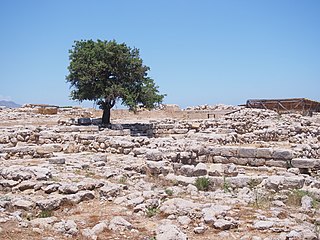
The Galatas Palace is a Minoan archaeological site on Crete discovered in the early 1990s. Built on a much older settlement, a Minoan palace was constructed in the early Neopalatial Period, sometime after 1700 B.C.E.. The palatial center was destroyed by an earthquake and abandoned later in the Postpalatial period, or around 1500 B.C.E.(LM IB)
Smari is a traditional small Cretan village, only 7 km (4 mi) away from the town of Kastelli and only 23 km (14 mi). away from Heraklion, which is the capital of the island of Crete. According to the 2021 census, it has 328 permanent inhabitants.
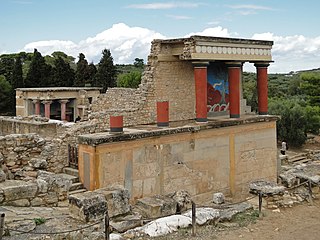
Minoan palaces were massive building complexes built on Crete during the Bronze Age. They are often considered emblematic of the Minoan civilization and are modern tourist destinations. Archaeologists generally recognize five structures as palaces, namely those at Knossos, Phaistos, Malia, Galatas, and Zakros. Minoan palaces consisted of multistory wings surrounding an open rectangular central court. They shared a common architectural vocabulary and organization, including distinctive room types such as the lustral basin and the pillar crypt. However, each palace was unique, and their appearances changed dramatically as they were continually remodeled throughout their lifespans.

Kavousi Vronda is an archaeological site in eastern Crete, Greece, located about 1.25 km south of the modern village of Kavousi, a historic village in the municipality of Ierapetra in the prefecture of Lasithi.

Kasteli International Airport — also known as the New International Airport of Heraklion, Crete — is an international airport under construction on the Greek island of Crete. Located in Kasteli, 39 km (24 mi) southeast of Heraklion, this new airport will replace the existing Heraklion International Airport and is expected to open by 2027. Kasteli Hellenic Air Force Base currently operates at this location as a military facility for the Hellenic Air Force, housing F-16 Fighting Falcon fighter aircraft from the 133 Combat Group.

Malia is a Minoan and Mycenaean archaeological site located on the northern coast of Crete in the Heraklion area. It is about 35 kilometers east of the ancient site of Knossos and 40 kilometers east of the modern city of Heraklion. The site lies about 3 kilometers east and inland from the modern village of Malia. It was occupied from the middle 3rd millennium BC until about 1250 BC. During the Late Minoan I period it had the third largest Minoan palace, destroyed at the end of the Late Minoan IB period. The other palaces are at Hagia Triada, Knossos, Phaistos, Zakros, and Gournia. It has been excavated for over a century by the French School of Athens and inscriptions of the undeciphered scripts Cretan hieroglyphs, Linear A, and the deciphered script Linear B have been found there.
